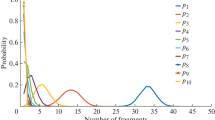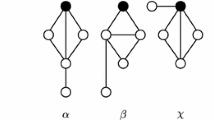Abstract
This paper describes some statistical properties of the nearest neighbor graphs (NNGs). We study the sample distributions of graphs by the number of disconnected fragments, fragments by the number of nodes, and nodes by the degrees of incoming edges. The statements about the asymptotic properties of these distributions for graphs of a large dimension are proved and their relationship with Young’s classical diagrams and Wigner’s semicircle distribution is noted. The problem of determining the probability of realizing a certain structure of the nearest neighbors depending on the distribution of distances between the elements of the studied set is considered. It is shown that, the NNG does not depend on the distribution of distances up to an isomorphism. This fact makes it possible to construct basic statistics using a uniform distribution, and to obtain tabulated data for the statistics of the NNGs as a result of numerical modeling. A study has been conducted on the conditional extremum of the probability of realizing the distribution of graph nodes by degrees, which allows us to estimate the proportion of randomness for a particular structure, which appears from clustering elements of a certain set by the nearest neighbor method. An algorithm for collecting the sample statistics of the NNGs using the specific features of such graphs is described.



Similar content being viewed by others
REFERENCES
T. Hastie, R. Tibshirani, and J. Friedman, The Elements of Statistical Learning (Springer, New York, 2001). https://doi.org/10.1007/978-0-387-21606-5
P. Erdös and A. Rényi, “On random graphs I,” Publ. Math. Debrecen 6, 290–297 (1959).
V. F. Kolchin, Random Graphs (Cambridge Univ. Press, Cambridge, 1999).
B. Bollobás, Random Graphs (Cambridge Univ. Press, London, 2001).
S. Janson, T. Luczak, and A. Rucinski, Random Graphs (Wiley, New York, 2000).
A. M. Raigorodskii, “Random graph models and their applications,” Trudy MFTI 2 (4), 130–140 (2010).
A. M. Raigorodskii, Models of the Internet (Intellekt, Dolgoprudny, 2013) [in Russian].
A.-L. Barabási and R. Albert, “Emergence of scaling in random networks,” Science 286 (5439), 509–512 (1999). https://doi.org/10.1126/science.286.5439.509
J. Leskovec, D. Chakrabarti, J. Kleinberg, C. Faloutsos, and Z. Ghahramani, “Kronecker graphs: an approach to modeling networks,” J. Mach. Learn. Res. 11, 985–1042 (2010).
V. S. Korolyuk, N. I. Portenko, A. V. Skorokhod, and A. F. Turbin, Handbook on Probability Theory and Mathematical Statistics (Nauka, Moscow, 1985) [in Russian].
G. H. Hardy and S. Ramanujan, “Asymptotic formulae in combinatory analysis,” Proc. London Math. Soc. 17 (2), 75–115 (1918).
A. M. Vershik and S. V. Kerov, “Asymptotics of the Plancherel measure of the symmetric group and the limiting form of Young tables,” Sov. Math. Dokl. 18, 527–531 (1977).
J. A. Anderson, Discrete Mathematics with Combinatorics (Prentice Hall, Upper Saddle River, NJ, 2001).
A. A. Kislitsyn and Yu. N. Orlov, “The investigation of the k-NN graph statistics,” KIAM Preprint No. 85 (Keldysh Inst. Appl. Math. RAS, Moscow, 2021) [in Russian]. https://doi.org/10.20948/prepr-2021-85
Author information
Authors and Affiliations
Corresponding author
Ethics declarations
The author declares that he has no conflicts of interest.
Rights and permissions
About this article
Cite this article
Kislitsyn, A.A. Investigation of Statistics of Nearest Neighbor Graphs. Math Models Comput Simul 15, 235–244 (2023). https://doi.org/10.1134/S2070048223020084
Received:
Revised:
Accepted:
Published:
Issue Date:
DOI: https://doi.org/10.1134/S2070048223020084




